Aseptic classic
California Aseptic Beverages LLC, Fontana, CA
rrrrMickies.JPG
, is on the fast track with Tetra Pak Inc. CAB started less than three years ago, and it already has five Tetra Pak lines including the A/3, which is Tetra Pak's fastest drink box machine, and the United States' only A/1 machine that produces Tetra Pak's Tetra Classic Aseptic tetrahedral package.Carlos Manrique, contract manufacturing manager for Tetra Pak, says, "Tetra Pak established its relationship with California Aseptic back in 2009 and immediately noticed the very customer-oriented focus and strategic business approach of the co-packer. California Aseptic has since transformed the entire floor plan and facility, maintaining the state-of-the art capabilities for packaging products, with several Tetra Pak filling machines installed.
"Their commitments to innovation and good service are definitely keys in this business. California Aseptic Beverage is one of the first co-packers to have a Tetra Classic machine installed in the U.S. and their work will come to support the introduction of the package in the North American market."
MICKIES 100 PERCENT JUICE
CAB president Jeff McClelland says, "California Aseptic is the only co-packer in the U.S. western states that co-packs 125mL and 200mL high-acid juice boxes for major brands using Tetra Pak. We started in 2010 with one TBA 9 line. We now have five lines, including the A3/Speed, and the A/1 machine. We are the only plant in the U.S. that has this machine. This classic package opens up new markets for us, particularly in the school and youth markets."
The first packages produced on the A/1are a quasi in-house brand for McClelland. He has established a company with his mother and brother called Kids Healthy Foods LLC that has introduced a line of 100 percent natural fruit juices in the Tetra Classic Aseptic packages under the brand name Mickies Slices.
McClelland says, "My brother and I have always wanted to get kids away from soda, so when Tetra Pak came to us to put in the A/1 line, we jumped at it. We had been thinking about a line of all-natural juice products with no preservatives or added sugar, and the Tetra Classic Aseptic is the perfect package for kids. It lays flat when you set it down instead of falling over, and the juice doesn't squirt out when you stick the straw into the package.
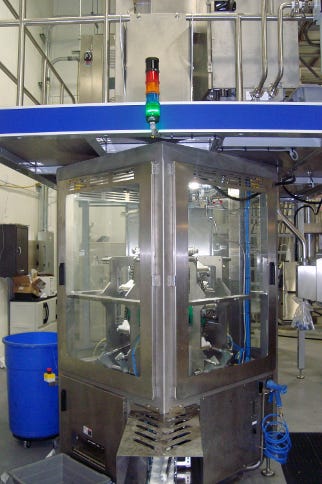
rrrrrCA1.jpg

rrrrrCA1.jpg
"We looked at school regulations nationwide to make sure that the products met all of their requirements. The line has some unique flavor profiles like pineapple/lemon and orange/mango, and kids have lik
ed it in taste tests.
"Juice boxes and pouches (Capri Sun) have been around for some time now, and kids are used to consuming their beverages out of those packages. Up until the Tetrahedron packaging that we are introducing to the U.S. market, there has not been any real innovation in the category as far as packaging and presentation. We are confident that the new Tetrahedron packaging creates excitement and fun in a category that has recently been stagnant."
CLASSIC MACHINE
PD visited CAB when the A/3 machine was installed earlier this year and did an article about the company in our May 2012 issue. In this issue, we are giving you a look at the A/1 machine, which is a classic Tetra Pak design. The difference from other Tetra Pak machines is the sealing section, where the Tetra Classic Aseptic tetrahedral shaped packages are formed.
The operation starts with the packaging material, which is a flexo-printed paperboard/foil/polyethylene laminate film, that is supplied by Tetra Pak in large rolls that yield about 29,000 packages each. The material is pulled from the roll and, as it travels up the back of the machine, a thin plastic strip is applied to one edge of the web to form the longitudinal seal of the package.
The film continues over the top of the machine and down into a sterilizing bath of 160 deg F, 32 percent hydrogen peroxide solution. A squeegee removes liquid peroxide, followed by a hot-air jet that blows off and evaporates the remaining peroxide.
The film passes an inkjet printer from Domino North America that applies the date and product code, jaw number and line, and 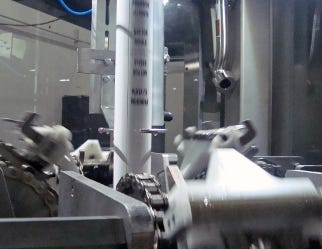
rrrCA2.jpg
lot numbers to the tube. The system also identifies boxes made from spliced material and rejects three consecutive boxes-the box contining the splice and the boxes before and after the box containing the splice.The flat, sterile material then travels back up and over a roller at the top of the machine and begins its descent through the cross-sealing section of the machine. As it descends, the material is wrapped around forming rings, where the plastic strip is heat-sealed to the other edge of the packaging material to form the longitudinal seam.
Next, the tube of film travels over a filling pipe that runs down its center. The liquid level inside the packaging material, which rises above the filling pipe, is regulated automatically to achieve the proper fill in the package. A servo control moves the material up or down in response to a photoelectric sensor that reads a mark on the package.
JAWS ARE UNIQUE
The tube of film containing the product then travels through the closing unit, which consists of four continuous vertical chains installed equidistant around the product-filled tube of film. Each chain has eight jaws. Unlike other Tetra Pak machines, which have two opposing sets of jaws and seal a package in one step, sealing on the A/1 is a two-step process.
As the filled tube travels downward, the first pair of opposing jaws close across the tube of film and form a seal. As the tube continues moving, the second pair of opposing jaws, which are spaced 90-deg around the tube from the first pair, close to form the second seal at a 90-deg rotation from the first seal, thus creating the unique tetrahedral package.
The jaws are equipped with induction heating bars that seal the ends of the cartons. A blade in the second set of jaws cuts the carton loose from the tube after the seal has been made. The sealing step simultaneously seals the top of the lower carton and the bottom of the carton above it before they are cut apart.
The cartons drop onto a horizontal conveyor and are conveyed past an automatic sampling system that, at intervals set by CAB, diverts boxes for inspection. The system selects boxes coded 1 to 8 by the printer, reflecting the sealing jaws on the vf/f/s machine. If a box is leaking, this enables CAB to identify which jaw is malfunctioning.
Following this, the packages travel to a Tetra Pak Model 30HS straw applicator that glues film-wrapped plastic straws to the drink boxes. The straws are supplied in a web that passes through a heating unit that heats the web to soften and straighten the straws.
To ensure precise appli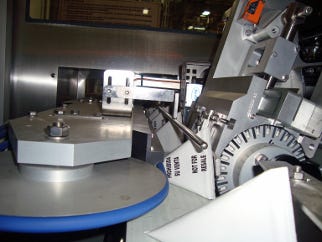
rrrrrCA7.jpg
cation of the straws, the cartons are lifted up from the infeed The machine cuts straws from the supply web and applies hot melt glue from a Nordson Corp. 3100V unit to each straw and places it against the side of the corresponding drink box. Pressure pads that move with the cartons help glue the straws to the packages.
A camera after the straw applicator inspects each carton for missing straws, and any such cartons are automatically ejected from the conveyor.
The A/1 filler and the straw applicator each have their own dedicated Allen Bradley programmable-logic controller and HMI from Rockwell Automation.
LINE MONITORING
The line incorporates Tetra Pak's Packaging Line Monitoring System (PLMS), which tracks the performance of the complete packaging line. The system collects operating data for each machine and the line as a whole-such as running and downtime, reason for a shutdown and other information-and transmits it every five seconds over the Rockwell network.
The PLMS also has a historical-analysis tool that can identify malfunction causes in the packaging line and a performance-analysis program that generates graphs and reports. All information from the monitoring system is sent to a separate line controller, which serves as the collection point. It then transmits the data, also over the Rockwell network, to other PCs in the plant. The data is also transmitted in real time to the Tetra Pak headquarters, where experts can provide advice and troubleshooting if it is needed.
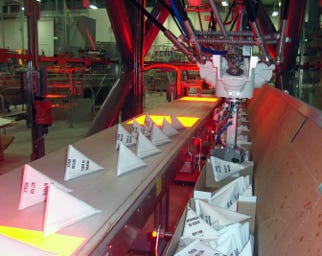
rrrrCA3.jpg
INTEGRATED SYSTEM
The Tetra Classic Aseptic Packages leaving the A/1 machine are conveyed to an integrated cutting-edge cartoning system from Delkor Systems Inc. that is composed of the latest generation Delkor Trayfecta S series carton former, four vision-based M3 robots from Fanuc Robotics America, Inc. and a Delkor Capstone T series carton closer.
Each machine uses an Allen-Bradley control platform with Panelview touchscreens for simple operation. The control system interacts with Tetra Pak's Packaging Line Monitoring System to gather production data and provide for a seamless transition from filling to packing.
Delkor Systems' sales manager, Rick Gessler, says, "This system is required to function at an extremely high efficiency level, with smooth transitions during production flavor changes and production starts and ends.
"There was a large effort in system programming and refinement to ensure proper control during each of these production phases to minimize wasted products or packaging. It was a great team effort by Tetra Pak and Delkor service technicians to deliver such a high-performance system."
CARTON FORMING
The cartoning process begins by forming a high-graphic carton in the Delkor Trayfecta former. Using three servo axis drives, the former picks the carton blank from a high-capacity magazine, transfers it with precision through the Nordson hot-melt system to apply a pre-defined adhesive pattern and forms a perfectly square carton using a forming head and spring-loaded forming cavity.
The completed carton is stripped from the forming head and ejected onto the carton transport conveyor with a positive eject mechanism that is integral to the forming head. The ergonomic magazine allows the system operator to replenish carton blanks while the former continues running, for uninterrupted production.
At the start of production, the formed cartons are introduced to the servo-driven flighted conveyor in the robotic cell by an escapement device and are staged for loading within the working range of the robots. Flexibility is a key consideration for this application, so future carton requirements are handled with a tool-less 3-min changeover based on cartridge style tooling.
CARTON LOADING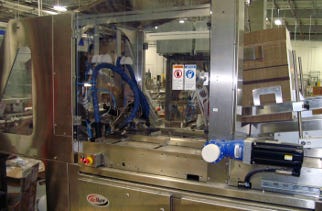
rrrrrrCA5.jpg

rrrrrrCA5.jpg
The tetrahedral-shaped packages produced on the A/1 filler enter the robotic cell for packing into cartons after being routed into two staggered lanes by a servo-driven diverter. As the packs transfer to the product belt in the robotic cell, they are transferred onto a lower speed belt that maximizes the package density on the conveyor prior to loading.
Vision-based product picking provides speed and flexibility for future pack-count variations. Each of the packages is conveyed over a light box in the conveyor that is monitored by overhead vision cameras. These cameras coordinate with the robots to pinpoint the location and orientation of each of the packages.
The robot control system tracks the position and orientation of the products on the continuous-motion product conveyor until the robot is able to pick them off of the belt for placement into the carton. This process repeats for each of the four robots, until all products are removed from the belt and packed into the cartons.
Products that do not conform to the pre-defined parameters of the vision system are allowed to pass through the system untouched and into a collection bin at the opposite end of the cell. This prevents possible downtime associated with picking products that are non-conforming.
Gessle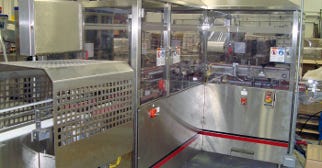
rrrrrCA6.jpg
r says, "This operation requires a tremendous amount of control. The Tetra Classic Aseptic packages, which have a straw glued to their side, are located randomly on the product conveyor. With the product and carton in motion, the robot must orient the gripper to match the inclined angle of the product, match the angle of orientation of the product on the conveyor, then move in three dimensions to match conveyor speed and securely pick the product. The robot then places the product into one of 10 pre-defined positions in the carton. What makes this system remarkable is that the four robots are coordinating to place several products per second into a carton with a very complex pack pattern."
Cartons leaving the robotic packer are conveyed to the Delkor Capstone T series carton closer. In the closer, Delkor's patented intelligent positioning technology ensures proper alignment of the carton graphics during the closing process. Simple tool-less changeover allows the carton closer to match the capabilities of the other line components.
McClelland says, "I can't say enough good things about Delkor. Their robotic cartoner is the future of packaging. I am running the entire line with two people and it would have taken probably six more to place the packages into cartons by hand. And they have been tremendous to work with. They were here during installation and start-up and trained our operators."
Sealed cartons are conveyed past an inkjet printer from Videojet Technologies Inc. that applies the date and product code, after which they travel to a palletizing station where they are palletized manually.
Delkor Systems Inc., 800-328-5558. www.delkorsystems.com
Domino North America, 800-444-4512. www.domino-printing.com
Fanuc Robotics America Inc., 800-477-6268. www.fanucrobotics.com
Nordson Corp., 770-497-3400. www.nordson.com
Rockwell Automation, 414-382-2000. www.rockwellautomation.com
Tetra Pak, Inc., 847-955-6000. www.tetrapak.com
Videojet Technologies Inc., 800-843-3610. www.videojet.com
About the Author(s)
You May Also Like


